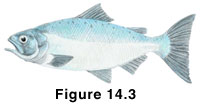 Description
DescriptionOncorhynchus kisutch (Coho
Salmon)
(Other common names: Silver Salmon, Hooknose)
Figure 14.3
 Description
DescriptionLength: 98 cm.
Mouth: large, terminal, directed forward; upper jaw extends beyond the posterior edge of orbit; snout is narrow; in both spawning males and females the jaws are hooked inwards; lips fleshy, teeth well developed and needle-like; no black colouration at the base of teeth, in spawning individuals the teeth become larger and hooked inwards (more expressed in the males).
Body: elongate; caudal peduncle compressed; caudal fin slightly indented; adipose fin small and slender; 19-25 widely spaced gill rakers over the first gill arch.
Color: metallic blue on dorsal with silver on the sides, the ventral area and the caudal peduncle; black spots on the upper lobe of the caudal fin; spawning males have bright red sides, bright green on the dorsal surface and head, with dark bellies.
Depth: pelagic schooling; 0-250 m.
Habitat: open Pacific offshore waters, coastal streams, and also lakes.
Season: spawns in the fall (October-November); fry appear in spring and usually spend one year in freshwater (sometimes longer); smolts will spend time in inshore waters before retreating to deeper offshore waters.
Diet: freshwater fry eat insects and larvae; young at sea feed on coastal plankton (e.g., copepods); adults feed on other forage species (e.g., herring, sand lance, greenlings, eulachon) and various planktonic crustaceans (e.g., copepods, euphasiids), squid.
Predators: larger fish species including other salmon (on young), sea birds, marine mammals, and terrestrial mammals.
Distribution: North Pacific; Baja, California to Alaska to Kamchatka, to Korea.
 Scale
Description
Scale
DescriptionRelative Size of Scale: moderate.
Position of Scale on Body: in rows above the lateral line canal 118-147; also on the lateral line canal 121-140 (Hart, 1973).
Overall Scale Shape: circular to somewhat oval anterior field, the posterior field can be irregular.
Focus and Circuli: focus is clearly defined and often centralized between the fields; often just anterior to the interface of the posterior field. The circuli are concentric with the scale outline. They are generally continuous between the lateral and anterior fields, but a small number of discontinuous circuli can be present. The posterior field is clear and some circuli may extend into it.
Radii: absent.
Remarks: Mosher (1969) stated that there are one or two freshwater annuli that can vary in size; the oceanic region usually has only one ocean annulus, but there can be two; there are greater than six complete circuli below the focus; the segments of the circuli are present and prominent features of the posterior field; and it is unlikely for there to be a reticulation pattern. Bilton et al. (1964) indicated that there must be at least one freshwater annuli; the reticulation must be absent; one ocean annulus must be present; and there will be 13 or more broken circuli in the posterior field.